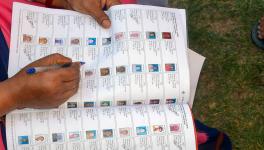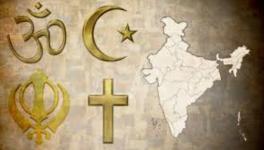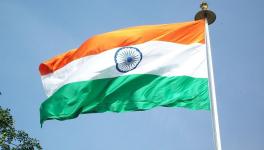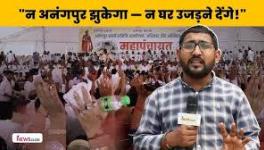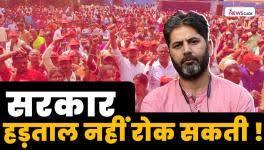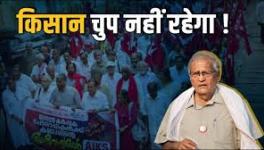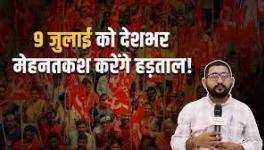Composite Indian Nationalism Vs. ‘Two Nation Theory’
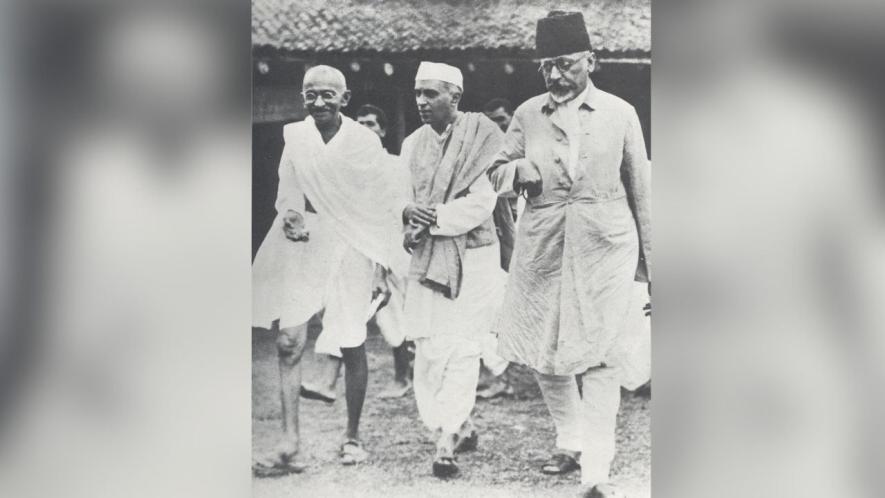
Jawaharlal Nehru with Mahatma Gandhi and Abul Kalam Azad, Wardha, August 1935. Image Courtesy: Wikimedia Commons
One of the greatest tragedies of South Asia has been the emergence of the ‘two nation theory’, which opposed the anti-colonial Indian national movement. It was a great help to British colonialists to rule over this vast land that led to the formation of Pakistan on the basis of Muslim majority (Islam) and the remaining part, India, as a secular state with a large Muslim population. These Muslims, who by force of circumstances or by choice, chose to stay here in India.
The Partition also led to large migration of Hindus from Pakistan to India and many Muslims to Pakistan. The suffering was horrific.
Now seven decades after the tragedy, on one hand, we see the plight of Pakistan, sliding down on the scale of democracy, social well-being and progress.
On the other, India, which began well and strove on the path of pluralism and development, is seeing the resurgence of the ‘two nation theory’ in the form of strengthening communal forces that are sharpening their politics to achieve a Hindu Nation.
B.R Ambedkar in his book on Partition had warned that the formation of Pakistan would be the worst tragedy as it may pave the way for Hindu Raj. How true was he!
The attempts of Gandhi, Maulana Azad and Congress to prevent the tragedy failed to counter the British policy of ‘divide and rule’, greatly assisted by the ideology and politics of communal forces of that time -- the Muslim League on one hand and Hindu Mahasabha-Rashtriya Swayamsevak Sangh (RSS) on the other.
The Partition debate and the underlying ‘two nation theory’ keeps surfacing time and again in both the countries. Sectarian nationalism, both Muslim and Hindu, keeps blaming each other for this tragedy. The feudal forces, assisted by the clergy on both sides, undermine the deep roots of the tragedy in the declining sections of society.
As both these sectarian streams were on the forefront of spreading hate against the ‘other’ community, communal violence went on intensifying and the figures, such as Gandhi and Maulana Azad, could not prevent the ghastly events that followed.
While each communal stream, Hindu and Muslim, have their own versions of this event, the holistic picture can be unearthed by seeing the picture through the movement and ideology of emerging Indian nationalism and its opposition by the declining sections of landlords and clergy on both sides.
This debate is once again in the news, thanks to Pakistan’s General Asim Munir. Addressing the Overseas Pakistani Convention in Islamabad, in the presence of top political leaders of the country, he eulogised the “two nation theory”. Munir went on to pay tributes to the people who worked for the formation of Pakistan.
Seeing one side of the picture, Munir stated, "Our religion is different, our customs are different, our traditions are different, our thoughts are different, our ambitions are different — that’s where the foundation of the two-nation theory was laid. We are two nations; we are not one nation.”
This in contrast to the understanding, particularly of Gandhi and Nehru, who saw the two major communities and other smaller religious communities as interacting with each other and creating a unique syncretic culture where each component has contributed to the emergence of celebratory Indian culture.
The common celebration of festivals at the social level and contributions of people to all aspects of Indian culture by people of diverse religions, with the unique Bhakti and Sufi traditions being the highest form of these interactions. Gandhi summed it up in his unique, Ishwar Allah Tero Naam, and Nehru articulated it as ‘Ganga Jamuni Tehzeeb’.
The ‘two nation theory’ was not a sudden articulation. As the national movement started emerging from among the sections of society associated with modern education, industries, and communication, Indian nationalism towered over all other fissiparous ideologies. As pointed out, the other sections not associating with it and hanging on the feudal and pre-modern values threw up the Muslim League on one side and Hindu Mahasabha, on the other. They were exclusionist and veered round propagating caste and gender hierarchy, standing opposed to education of Dalits and women.
The British subtly supported these trends, as these were helpful for them in suppressing the National Movement. One talked of Islamic Nation and the other of Hindu Nation. Immediately after the formation of the Indian National Congress, the opposition to this came up in the form of Rajas and Nawabs pledging their loyalty to the British rulers. Gradually these parallel streams emerged and the Muslim League was formed in 1906. This was encouraged by the British.
On the other side, the Punjab Hindu Sabha came into being in 1909, Hindu Mahasabha in 1915 and RSS in 1925. Both these sections criticised Gandhi to the hilt.
Formally, the ‘two nation theory’ was articulated by Vinayak Damodar Savarkar and that became the guiding light of Hindu Nationalism. Muslim nationalism started talking of Pakistan by 1930 and was strongly articulated in 1940 by Muhammad Ali Jinnah in 1940.
Today, RSS ideologues (Bharatiya Janata Party leader and RSS leader Ram Madhav: ‘Decoding General’, Indian Express, April 19, 2025) are projecting as if the ‘two nation theory’ was only the making of Muslims through the Muslim League. They underplay the great role of Allah Baksh, Maulana Azad and Khan Abdul Gaffar Khan, who were opposed to the demand of Pakistan.
Pakistan, which was formed on the ‘two nation theory’ just after 25 years of existence, broke down into Bangladesh and Pakistan. That was the grave of the “two nation theory”. The abysmal condition of both countries is obvious today.
In India, Hindu Nationalism was being nurtured in a silent manner. Its first dangerous manifestation came when RSS-trained Nathuram Godse pumped three bullets into the bare chest of the ‘Father of the Nation’. Its further starkly visible form came up in the decade of 1980 with the most divisive campaign for demolishing the Babri Masjid.
Pakistani poet Fahmida Riyaz, at this point, wrote: Arre Tum Bhi Hum Jaise Nikle, Ab tak Kahan Chhupe thhe Bhai. (Oh, you have turned out to be like us, where were you hiding so far!).
After this, the attacks on the concept of secularism, inclusive politics and values of the Indian Constitution were intensified, and now emotive issues have taken centre-stage.
The product of the “two nation theory” – Pakistan-- is in the grip of Mullahs-Army and has been servile to the US. The other component of the ‘two nation theory’ -- a Hindu Nation -- has also more or less occupied the centre-stage in India.
The values and outcome of nationalism on both sides of the divide are the same, only the form is different. The criticism of the ‘two nation theory’ and attributing it only to Muslims is a half- truth!
The writer is a human rights activist, who taught at IIT Bombay. The views are personal.
Get the latest reports & analysis with people's perspective on Protests, movements & deep analytical videos, discussions of the current affairs in your Telegram app. Subscribe to NewsClick's Telegram channel & get Real-Time updates on stories, as they get published on our website.









